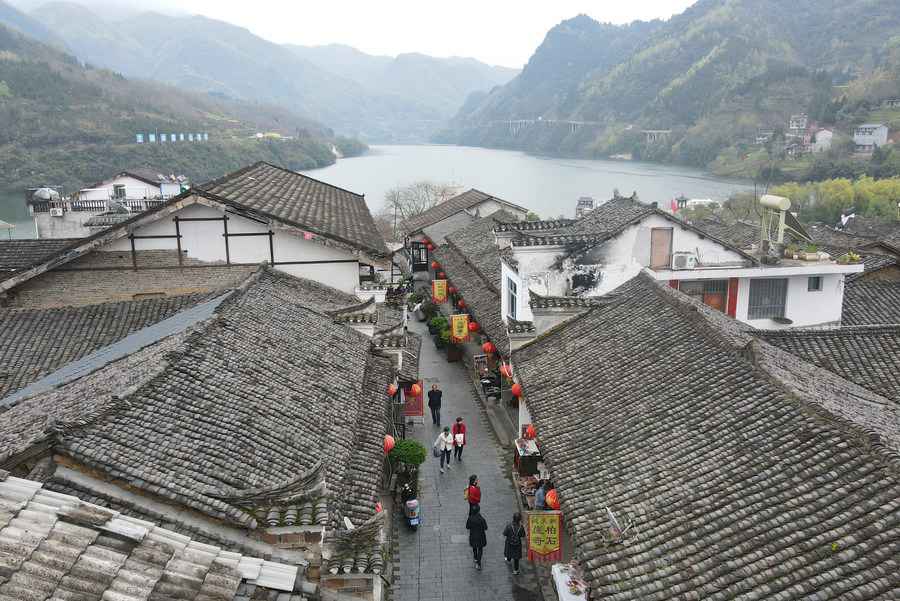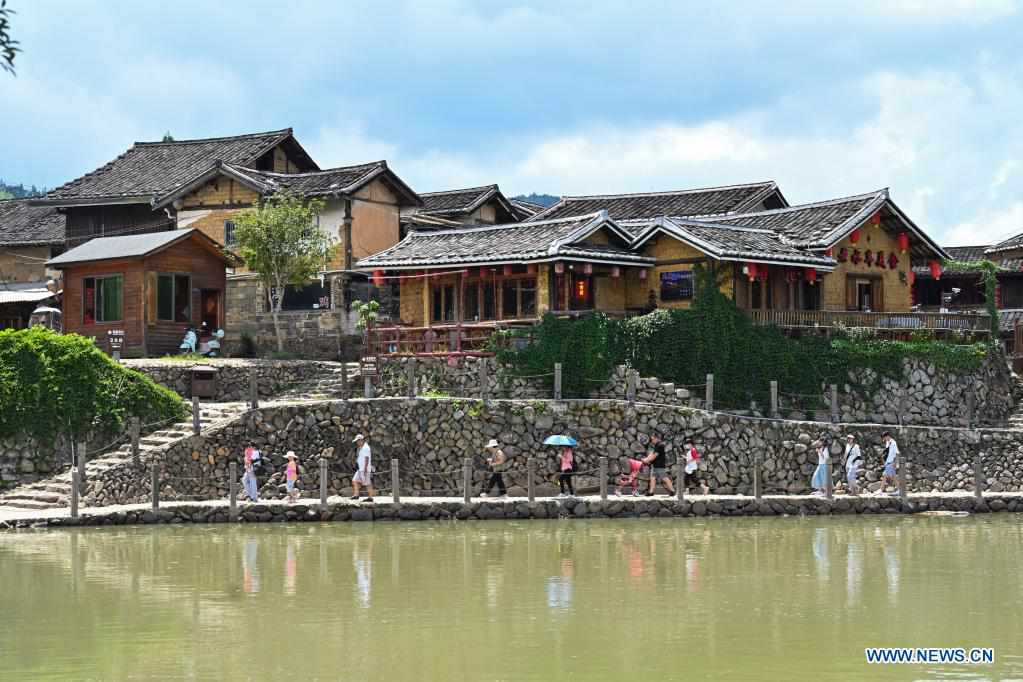Booming rural tourism expands domestic travel choices while helping boost rural development

Aerial photo taken on March 19, 2021 shows tourists visiting the ancient Houliu Township in Shiquan County of Ankang City, northwest China's Shaanxi Province. (Xinhua/Shao Rui)
Rural tourism has been thriving in China, with high-quality tourism destinations and routes attracting numerous tourists, which has helped drive continued rural development, a trend that is being underpinned by the country's favorable measures to support the development of the sector.
To promote the high-quality development of rural tourism, China's Ministry of Culture and Tourism (MCT), together with the National Development and Reform Commission, has included 1,199 villages in the country's list of key villages for rural tourism. In 2021, the two departments announced a list of key rural tourism townships, the first of its kind. A total of 100 townships nationwide made it onto the list.
Last year, the two departments also launched a total of 300 rural tourism routes, allowing tourists to take a closer look at the country's achievements in poverty alleviation and rural vitalization.
Thanks to the development of rural tourism, more jobs have been created for villagers; living environments and infrastructure have been improved, and digital villages have been built. Statistics show that rural tourism has contributed to more than 40 percent of employment in national key villages for rural tourism, becoming a main channel for the employment of villagers residing in these localities.
"Rural tourism plays an important role in enhancing the added value of the primary industry and secondary industry while driving the development of sectors such as commerce, services, and transportation," said Wu Liyun, a tourism expert with the Beijing International Studies University.
As rural tourism develops, rural infrastructure and public services have been constantly improved, and villagers' awareness towards the protection of the natural and human-made environment has been enhanced, creating a better overall development environment for rural areas, Wu added. Meanwhile, rural tourism can boost the local economy, attracting young people who previously had worked elsewhere to come back to start up their own businesses or find jobs.

Tourists visit Yunshuiyao ancient town in Nanjing County, southeast China's Fujian Province, Aug. 17, 2021. (Xinhua/Song Weiwei)
All parts of China have been exploring ways to better develop rural tourism. The development of rural tourism has brought tremendous changes to Sanhe village of Xindu district, Chengdu city, southwest China's Sichuan Province.
Walking into the village, one can see well-arranged green belts and restaurants, palm-fringed white tents, and rows of ball-shaped homestays.
Roads in Sanhe used to be unsurfaced, recalled Tan Jie, Party chief of the village. Since 2013, Sanhe has made great efforts to promote rural tourism, turning the relatively unknown village into a popular tourism destination.
After pooling together its resources, the village has introduced 24 music and cultural programs in addition to five boutique homestays, having meanwhile held a variety of activities, such as music festivals and concerts featuring folk music. Each year, the village receives over 200,000 tourists, garnering a total tourism revenue of more than 30 million yuan (about $4.7 million). In 2020, villagers' per capita net income in Sanhe was 32,410 yuan, with the collective income of the village standing at 1.62 million yuan.
To avoid homogeneous competition, the Hengjing neighborhood in Wuzhong district, Suzhou city, east China's Jiangsu Province, upgraded its rural tourism services in Lindunuan village by cooperating with Tongcheng Group, the parent company of leading Chinese online travel agency Tongcheng-Elong, turning the village into a popular rural tourism destination where tourists are able to receive one-stop services.
Lindunuan has developed diversified and customized tourism products that cover nature-related education, parent-child activities, art and culture to meet the demands of tourists of different age groups and consumption habits, driving the development of sectors such as accommodation, catering, entertainment, and education. Since Oct. 2021, the village has received nearly 300,000 visitors.
The MCT will continue to drive the high-quality development of rural tourism in the years ahead as a way to boost local people's incomes while offering superior services to tourists.
Photos
Related Stories
Copyright © 2022 People's Daily Online. All Rights Reserved.










